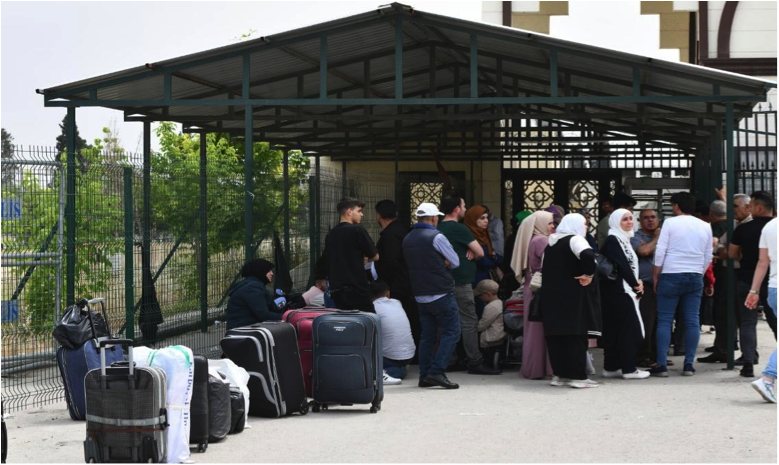by: Rasha Istaiteyeh, Hashemite University
Return Aspirations of Syrian Refugees in Jordan
Studies have found that the majority of Syrian refugees in Jordan aspire to return to Syria but their return plans are contingent on the improvement of security conditions and the availability of essential services in Syria. Syrian refugee family networks and social capital play a significant role in shaping return aspirations, with refugees who have strong family networks and social capital in Syria being more likely to aspire to return. Syrian refugee youth in Jordan also have high aspirations for the future to return to Syria. However, they are also aware of the challenges of returning to Syria, and many are considering alternative pathways, such as migration to Europe.
Return Aspirations (Micro level)
In 2023, the aspirations of Syrian refugees in Jordan to return home reveal an evolving landscape. The latest data reveals a shift in sentiment. A majority (of about 97%) of Syrian refugees in Jordan refuse to return within the next year. This percentage in Jordan is considered one of the highest amongst its neighboring countries.
The UNHCR survey indicates that the intention to return has decreased from 2.4% in 2022 to 0.8% in 2023. These intentions are influenced by factors such as security improvements and livelihood opportunities, as well as safety concerns, limited livelihood opportunities, and inadequate housing. These findings are consistent with earlier research, suggesting that the aspiration and reality of returning to Syria remain complex and challenging for most Syrian refugees.

Table 1 indicates a noticeable uptick in 2018, particularly post-October following the reopening of the Jaber-Yanassib crossing border, which had been shut for three years to civilian movement and trade. This increase coincided with the Syrian army’s successful operation, supported by Russia, to oust opposition militants from their bastion in southwestern Syria.
Jordanian Governmental Policy on Return
The Jordanian government’s approach to Syrian refugee returns has been pragmatic. Jordan maintained a relatively restrictive stance, emphasizing that all refugee returns will be voluntary. It expressed concern regarding the safety and security of the Syrian refugees in their country due to the lack of essential services.
However, the government allowed relaxed visa requirements for refugees willing to visit Syria and is offering financial support to the refugees returning to Syria. Jordan works together with the UNHCR in an attempt to make sure that any return procedures are carried out voluntarily and safely.
Jordan’s approach is highlighted by its commitment to International customary law and the principle of non-refoulement under International human rights law. Jordan also pledged not to return individuals as they are committed under the UN’s 1966 International Covenant on Civil and Political Rights.
Motivation behind Syrian Refugees’ Voluntary Return
Syrian returnees have different motivations that reflect the changing complexities of the situation. Although family reunification continues to be the most important motivational factor , especially for senior relatives who want to reside next to their families, other factors shape decisions about return. Most Syrian elders wish to go back to spend their last days in their country. The possibility that some individuals return to Syria to sell their property to finance their way to Europe suggests economic motivation. A category of returnees goes back to rebuild their country as they see no future in their host country. Others return due to the conditions in their host countries, as they face challenges living under the poverty line. In Jordan, only two percent of refugee households can meet their essential food needs. Furthermore, refugees feel alienated in their host countries. Furthermore, refugees in host countries face discrimination, as 43% claimed they could not cope with facing humiliation and discrimination in their host countries.
According to the World Bank’s analysis, refugees who are not part of a nuclear family (parents and child), who are single, or who are male, are more likely to return to Syria. People with extended family members are 12% more likely to return than those with nuclear families. Single refugees have a 2.7% higher chance of returning. Male refugees are 0.6% more likely to return than female refugees.
The Syrian refugees in Jordan face a complex web of challenges that make the prospect of returning to their homeland far from straightforward. Despite the relative stability in parts of Syria, the lingering uncertainties about safety, the absence of a comprehensive peace settlement, and the widespread destruction of infrastructure dissuade many from considering a return. Moreover, the deep psychological scars of war, alongside the loss of property and the lack of economic opportunities in Syria, add layers of reluctance. Integration into Jordanian society has been another factor; many refugees have started to rebuild their lives, with children attending schools and adults finding new livelihoods, furthering them from the idea of returning. The Jordanian government, NGOs, and international aid have been pivotal in providing support systems that, for now, have created a semblance of a new normalcy for the refugees. Given these reasons, it appears that a return to Syria is not in the horizon for the majority of the Syrian refugees in Jordan, as the cost of going back – in every sense – seems to overshadow the prospect of return.


